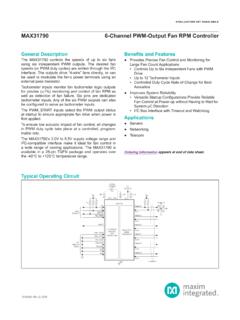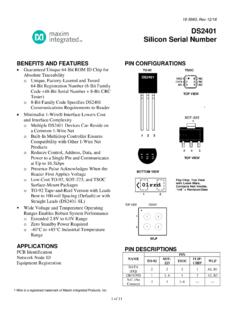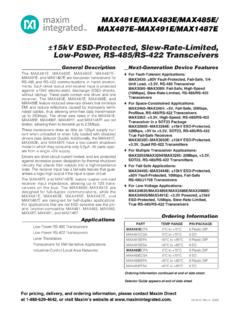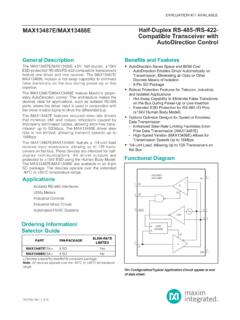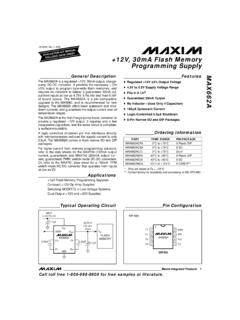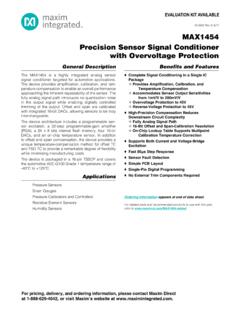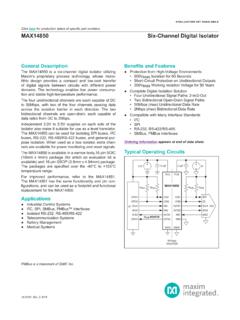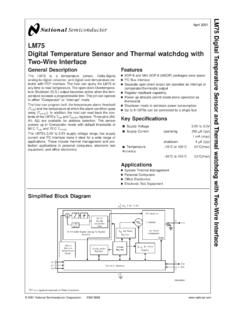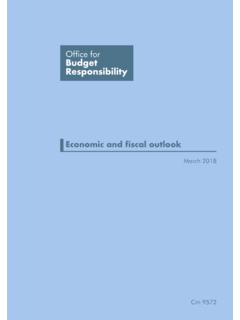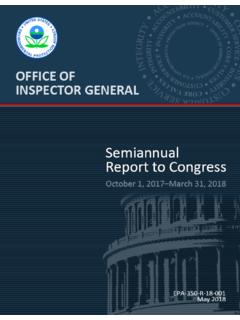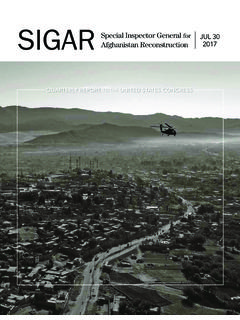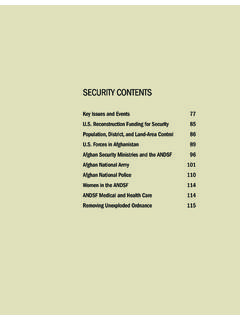Transcription of DS1558 Watchdog Clock with NV RAM Control
1 1 of 18 REV: 071305 Note: Some revisions of this device may incorporate deviations from published specifications known as errata. Multiple revisions of any device may be simultaneously available through various sales channels. For information about device errata, click here: FEATURES Integrated Real-Time Clock (RTC), Power-Fail Control Circuit, and NV RAM Controller Clock Registers are Accessed Identically to the Static RAM; These Registers are Resident in the 16 Top RAM Locations Century Register Greater than 10 Years of Timekeeping and Data Retention in the Absence of Power with Small Lithium Coin Cell(s)
2 And Low-Leakage SRAM Precision Power-On Reset Programmable WAlarm BCD-Coded Year, Month, Date, Day, Hours, Minutes, and Seconds with Automatic Leap-Year Compensation Valid Up to the Year 2100 Battery Voltage-Level Indicator Flag Power-Fail Write Protection Allows for 10% VCC Power-Supply Tolerance Underwriters Laboratory (UL) Recognized PIN CONFIGURATION ORDERING INFORMATION PART TEMP RANGE VOLTAGE (V) PIN-PACKAGE TOP MARK* DS1558 Watchdog Clock with NV RAM atchdog Timer and RTC DS1558W -40 C to +85 C 48 TQFP (7 x 7 x 1mm) DS1558D DS1558W+ -40 C to +85 C 48 TQFP (7 x 7 x 1mm) DS1558D DS1558W-TRL -40 C to +85 C 48 TQFP (7 x 7 x 1mm) DS1558D DS1558W+TRL -40 C to +85 C 48 TQFP (7 x 7 x 1mm) DS1558D DS1558Y -40 C to +85 C 48 TQFP (7 x 7 x 1mm) DS1558B DS1558Y+ -40 C to +85 C 48 TQFP (7 x 7 x 1mm)
3 DS1558B DS1558Y-TRL -40 C to +85 C 48 TQFP (7 x 7 x 1mm) DS1558B DS1558Y+TRL -40 C to +85 C 48 TQFP (7 x 7 x 1mm) DS1558B + Denotes a lead(Pb)-free/RoHS-compliant device. * A + anywhere on the top mark indicates a lead-free device. VCC A17 GND RST DQ0DQ1DQ2DQ6 VBAT1 WEIRQ/FTA8 OEA10 CEX1 GND VBAT2 A15A13 OERA9A1135 36 34 33 32 313029282726 2524 23 22 21 20 19 18 17 16 15 14 13 123456781012119484746454443424140393837 CERDQ7DQ5DQ4DQ3 GNDA0DS1558 X2 TOP VIEW DS1558 2 of 18 PIN DESCRIPTION PIN NAME FUNCTION1, 13, 39 No Connection 41.
4 43 2 A18 3 A16 4 A14 5 A12 6 A7 7 A6 8 A5 9 A4 10 A3 11 A2 12 A1 14 A0 27 A10 29 A11 30 A9 31 A8 32 A13 36 A15 44 A17 r Ad ess Decode.
5 T einputs to determine read o write cycle should cted to the attached SRAM or to the Address Inputs fowhether or not a RTC DS1558 uses the address rbe dire15 DQ0 16 DQ1 17 DQ2 19 DQ3 20 DQ4 21 DQ5 22 DQ6 23 DQ7 Data Input/Outputs. Data input/output pins for the RTC registers. 18, 45, 48 GND Ground 24 CER Active-Low Chip-Enable RAM.
6 CE is passed through to CER, with an added propagation delay. When the signals on A0 A18 match an RTC address, CER is held high, disabling the SRAM. If OE is also low, the RTC outputs data on DQ0 DQ7. 25 OER Active-Low Output-Enable RAM. OE is passed through to OER, with an added propagation delay. When the signals on A0 A18 match an RTC address, CER is held high, disabling the SRAM. If CE is also low, the RTC outputs data on DQ0 DQ7. 26 CE Active-Low Chip-Enable Input. Used to access the RTC and the external SRAM.
7 28 OE Active-Low Output-Enable Input. Used to access the RTC and the external SRAM. 33 IRQ/FT Active-Low Interrupt/Frequency-Test Output. This pin is used to output the alarm interrupt or the frequency test signal. It is open drain and requires an external pullup resistor. 34 WE Active-Low Write Enable. Used to write data to the RTC registers. DS1558 3 of 18 PINCRIPtinNAMEON DESTION (conued) PIN FUNCTI 35 VBAT1 37 VBAT2puts foy StaelEnergy Source. Battery ust be betwr pation.
8 UL recognized to ainst ree chaedium battery. If only one used, it should bnduld be grounded. See ns of battery isBattery Inr Anndard +3V Lithium Cl or Other voltage mheldeen and foroper operensure agversrging current when us with a lithe attached to VBAT1, a VBAT2 sho Conditioity at 38 RST CC is out of tolerance. On power-up, the system to stabilize. TheActive-Low Power-On Reset Output (Open Drain). This pin is an output used to signal RST is held low for a period of time to allow RTC and SRAM are not accessible while RST is active.
9 This pin is open drain and requires an external pullup resistor. that V40 VCCO VCC Output to RAM. While VCC is above VBAT, the external SRAM is powered by VCC. When VCC is below the battery level, the SRAM is powered by one of the VBAT inputs. 42 VCC Power-Supply Input. DC power is provided to the device on these pins. VCC is the +5V input. When 5V (or for the version) is applied within normal limits, the device is fully accessible and data can be written and read. Reads and writes are inhibited when a 3V battery is connected to the device and VCC is VTP.
10 However, the timekeeping function continues unaffected by the lower input voltage. As VCC falls below VBAT, the RAM and RTC are switched over to the external power supply (nominal DC) at VBAT. 46 X1 47 X2 Connections for Standard Quartz Crystal. The internal oscillator circuitry is designed for operation with a crystal having a specified load capacitance (CL) of 6pF. For more information about crystal selection and crystal layout considerations, refer to Application Note 58: Crystal Considerations with Dallas Real-Time Clocks.

